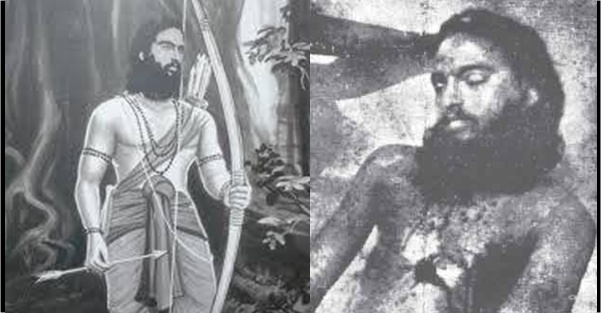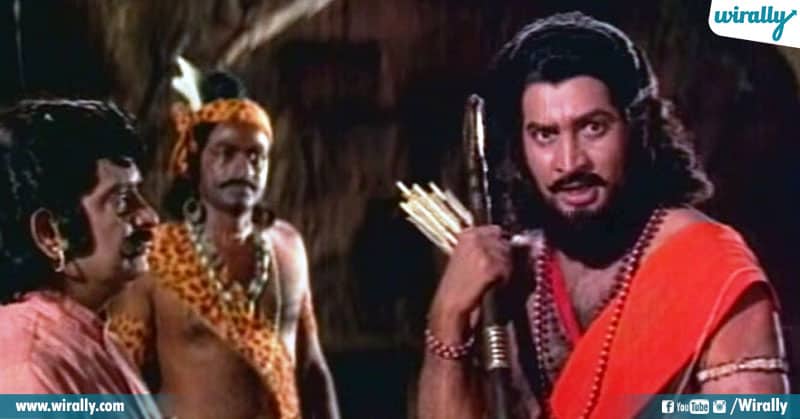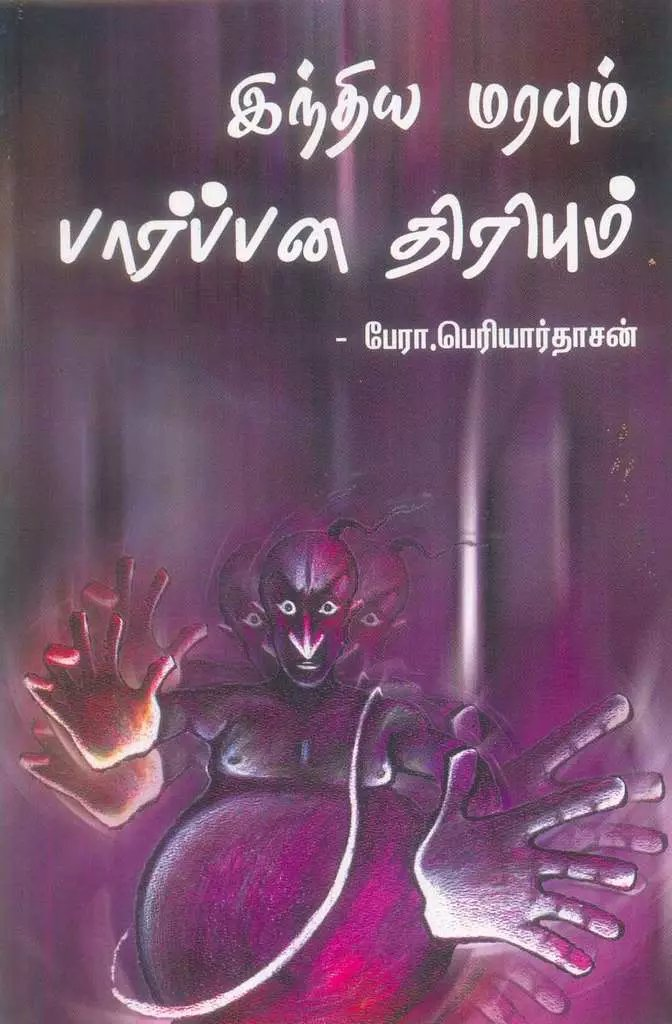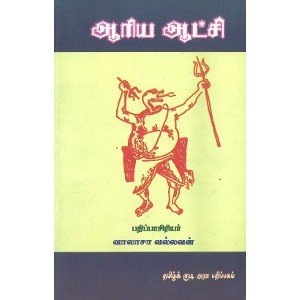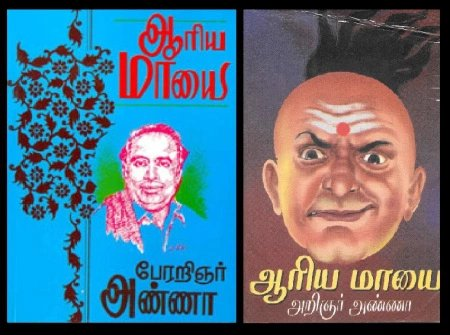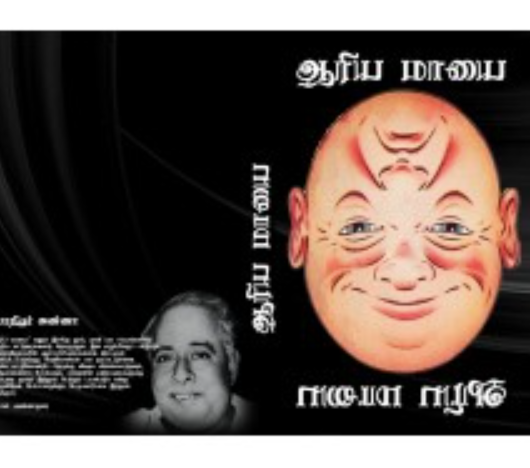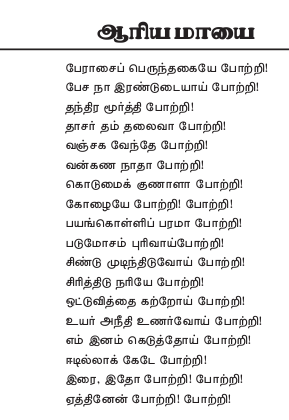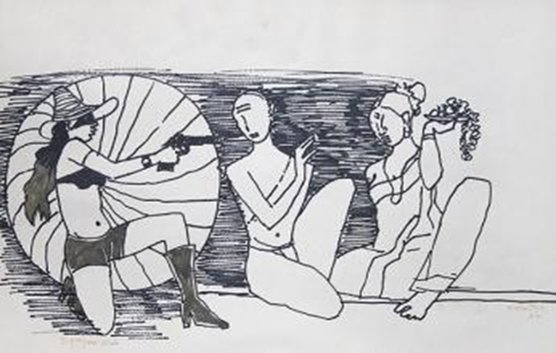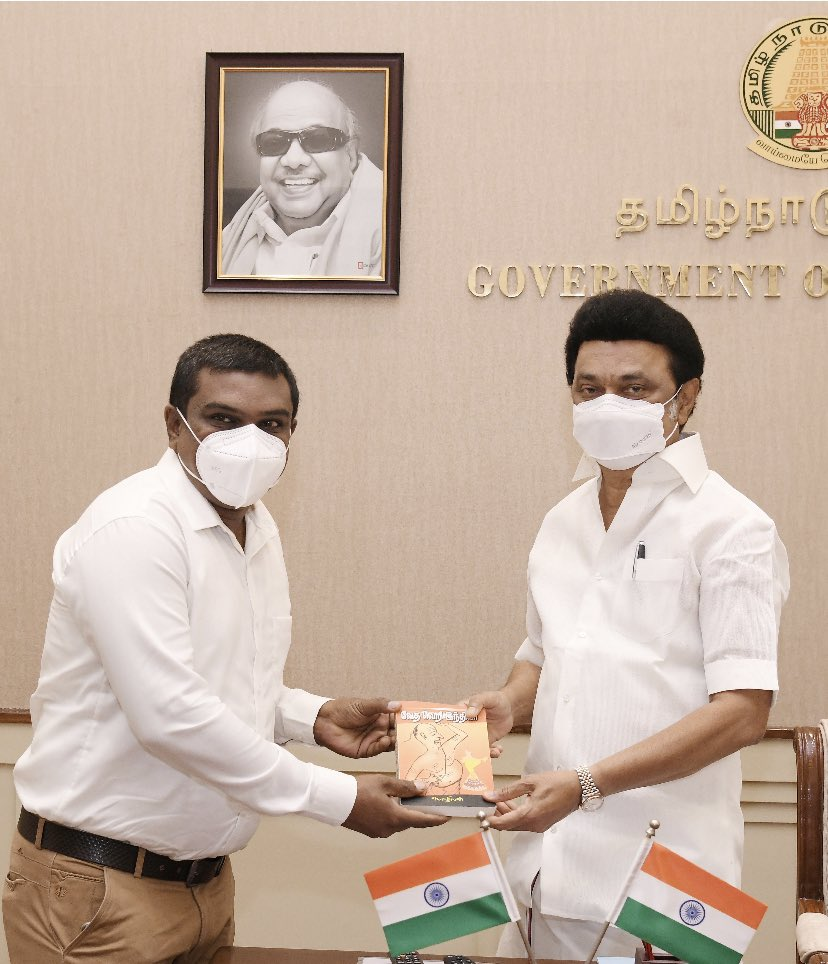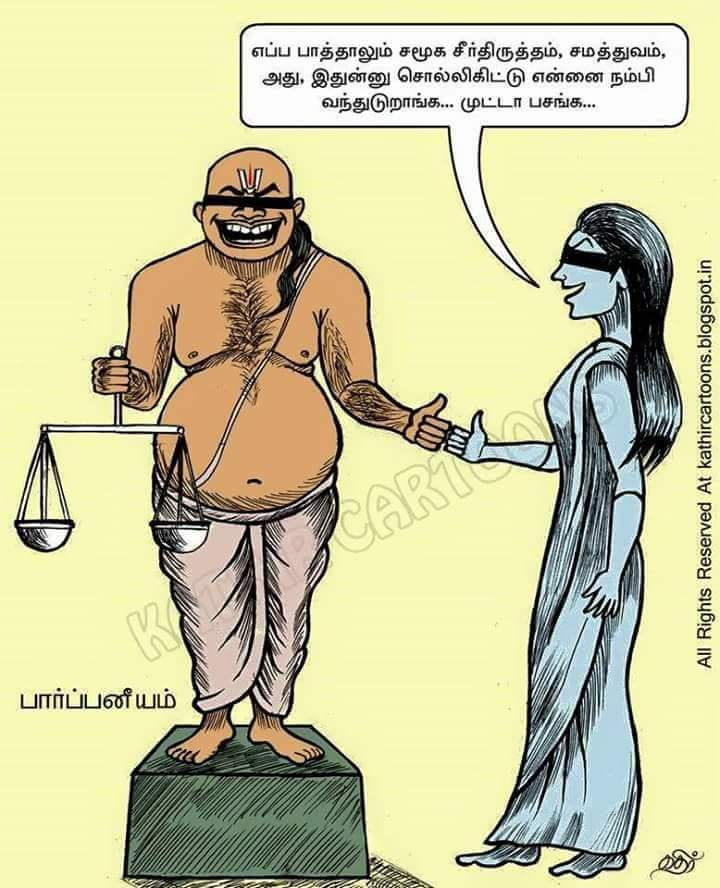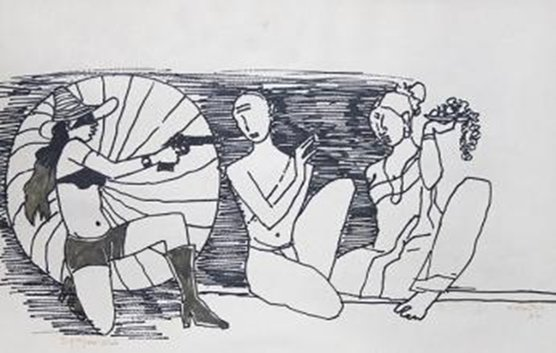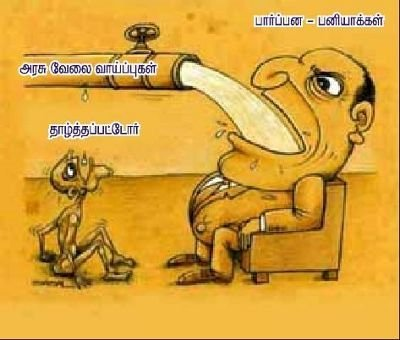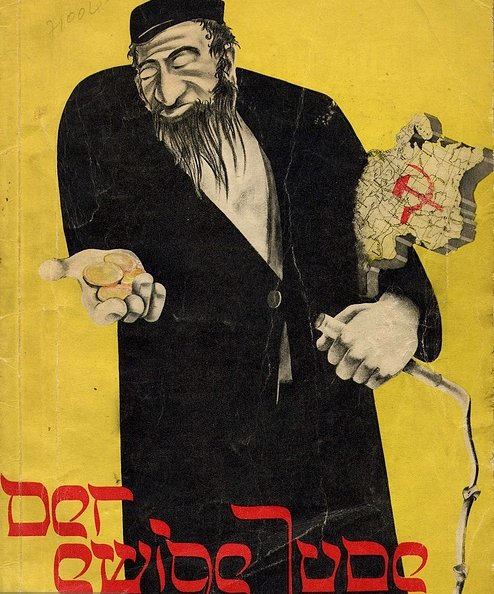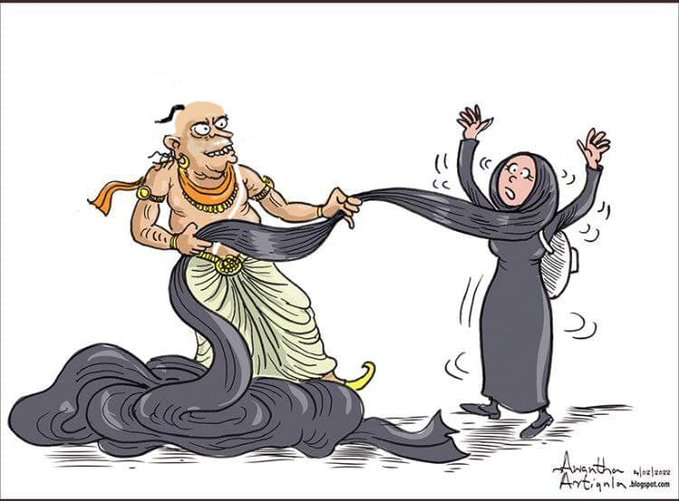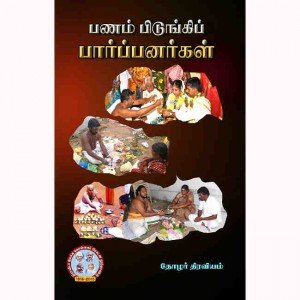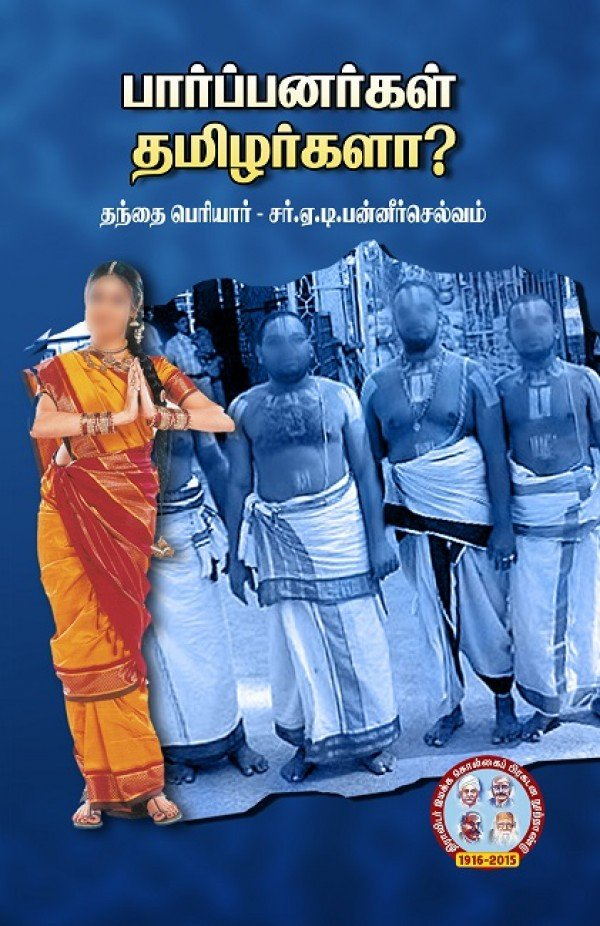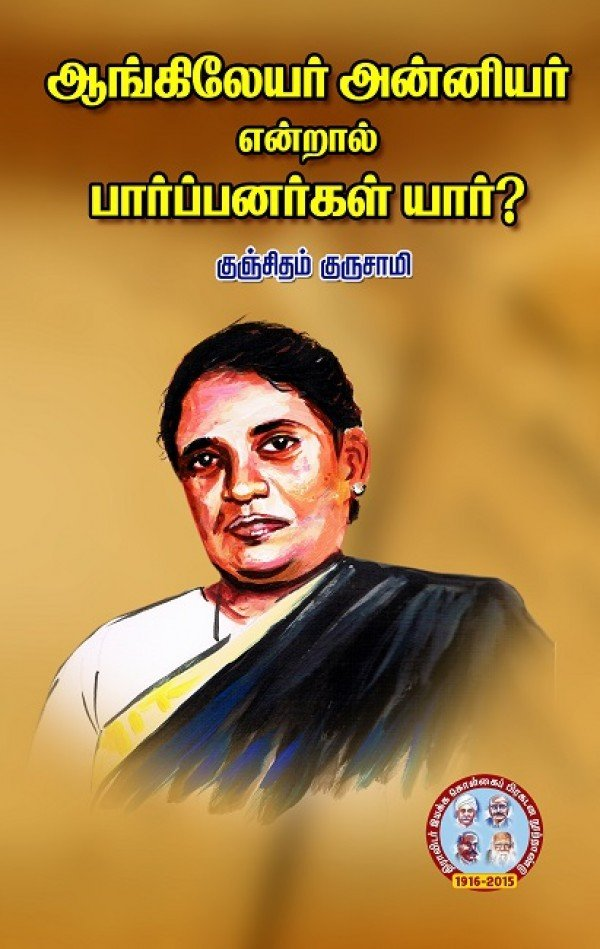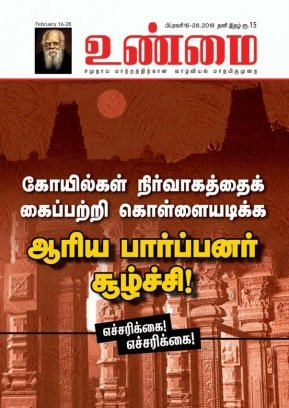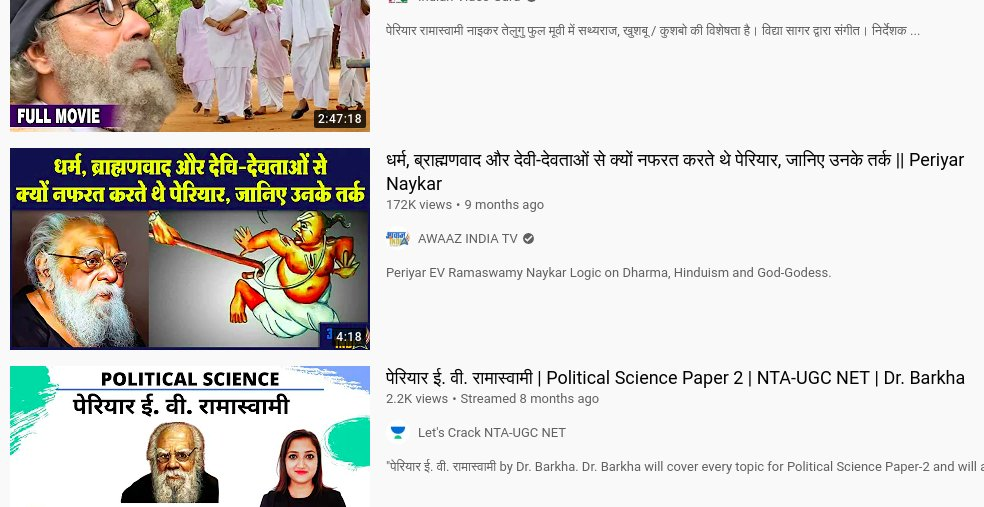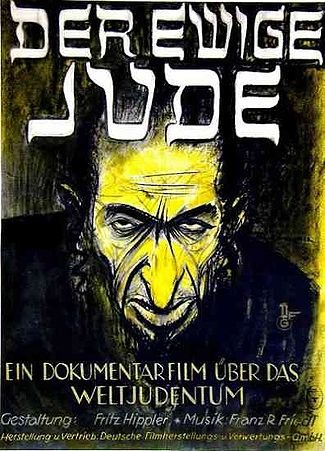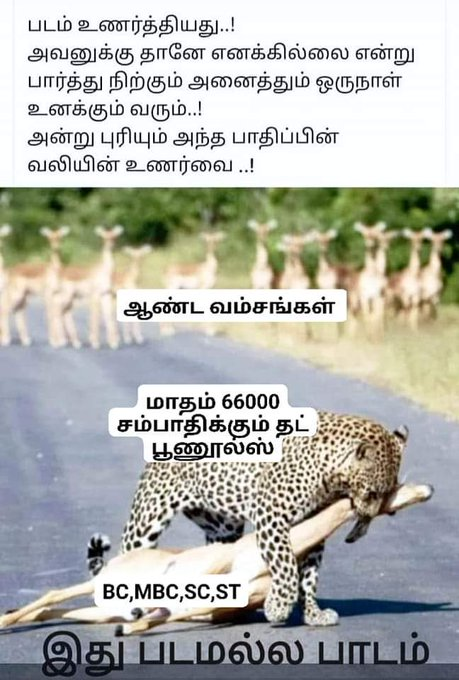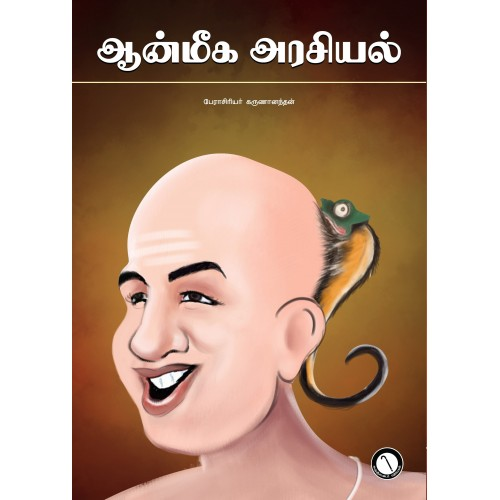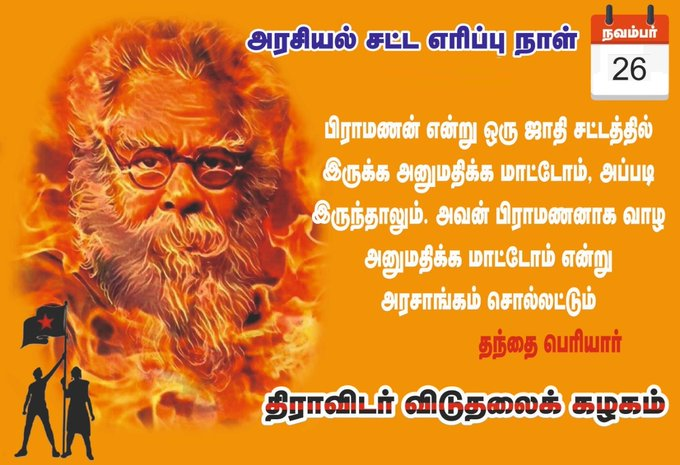Understandable since memories of British colonization & their impoverishment of India while starving the people to death are still fresh. However, the French East India company had also colonized parts of India.
श्लोकार्घेन प्रवक्ष्यामि यदुक्तं ग्रन्थकोटिभिः। ब्रह्म सत्यं जगन्मिथ्या जीवो ब्रह्मैव नापरः।
Sunday, December 11, 2022
Indian support for France: a historical political overview
Understandable since memories of British colonization & their impoverishment of India while starving the people to death are still fresh. However, the French East India company had also colonized parts of India.
Monday, November 14, 2022
The unbaked pot
Gora Kumbhar, the potter had a few guests. The four siblings, Nivritti, Gnaneshwar, Sopan & the little sister Mukta Bai had arrived, along with Namadevar.
The little Mukta, the embodiment of Shakti, decides on a small Leela (play) & asks the old potter.
"How do you make pots?"
"Just as Panduranga makes everything & everyone as pots from the 5 elements of earth, water, fire, air & space, I make pots from just earth".
"How do you decide if the pot is correctly baked?"
"I hit it with a stick & listen to the sound".
"Can you also hit us, the pots of Panduranga, with this stick & see if we're baked or unbaked? Please Mama (uncle), Please. My brothers first."
Gora Kumbhar gently taps a smiling Nivritti, Gnaneshwar & Sopan.
"Please tap me, please..."
Gora Kumbhar gently taps a giggling Mukta. Namadevar is just sitting aloof.
"Mama, please tap Namadevar Mama as well."
Gora Kumbhar hesitates. Namadevar doesn't seem too approving.
"Oh please, tap him as well."
Gora Kumbar taps Namadevar, who explodes in rage. "What kind of a stupid game is this?"
Now, Mukta says: "Oh, so this is the unbaked pot!"
With a face blackened with anger & humiliation, Namadevar storms out, ignoring Gora Kumbhar's apologies & explanation that he was only humoring a child.
He repeatedly complains to Panduranga. "Me, your Bhakta, who is constantly singing your names & your glory, how could I be subject to such humiliation?" When normally he would get a response, he gets only a surprising silence. Dejected, when he goes to take his life, finally he gets a response. "It is you who has humiliated my Bhakta, Gora Kumbhar by storming out when ignoring him. And Mukta is right; you are an unbaked pot. Find yourself a Guru & get yourself ready."
And Namadevar goes in search of a Guru. (Read that story here.)
Monday, October 10, 2022
Ponniyin Selvan I - historical musings
The movie keeps referring to Sri Lanka as Lanka (Ilangai). This name is fairly recent. The right name should have been SwarnaDvipa, Tamraparni or Simhala. Simhala was populated by people from Kalinga (now Odisha). Sinhala is Samskritam based & still has similarities to Odisha. https://bharatbhumika.blogspot.com/2015/11/geography-of-ramayana.html
The movie accurately refers to Ashoka's daughter respectfully in Simhala. After Ashoka converted to Buddhism, his children become missionaries. Sanghamitra does go to Simhala & the people convert to Buddhism under her influence. However, the Mauryan empire collapses after Ashoka.
In war scenes, the warriors are not wearing war helmets that protect the nose. In a beach battle, ArulMozhi is wearing a turban. In the middle of a battle, he removes his turban. I understand that actors are paid for their expressions & the need to show them to the audience. A better way would be to show the war helmet getting knocked off in battle. Gowarkar does this well in Panipat.
Also, in the beach battle, the Chozha army is shown coming ashore while the Sinhala army is waiting. Either the ships need projectile weapons to provide covering fire to the boats coming ashore, or the soldiers need to come ashore in stealth. Else, the beach landing will fail. This battle could have been better thought through. Also, an unarmed ArulMozhi swimming to the enemy ship while they were watching would be easily captured. It was unrealistic to show him climb unarmed & then defeating multiple warriors.
Sundara Chozhan is shown as being treated with acupuncture by Chinese physicians. Varma Kalai, a part of Hindu martial arts like Kalari Payattu, used acupressure. This was introduced to the Shaolin temple by Buddhabhadra who founded it in 496 CE, the 1st abbot & later by Bodhidarma, the 2nd abbot. The acupressure martial arts techniques were later developed into acupuncture by the Chinese. But this would have taken multiple centuries. It seems incongruous to show this treatment in the movie. The director could have shown acupressure or some kind of oral medicine. https://www.facebook.com/trueindology.org/posts/this-painting-from-ancient-shaolin-temple-china-depicts-the-indian-monk-buddhabh/1134417563425428/
Friday, October 07, 2022
Ponniyin Selvan I - movie review
Wednesday, September 21, 2022
From the Purusharthas to Financial Security-Talk outline
- Disclaimer
- FIRE, Fat FIRE (better lifestyle), Lean FIRE (Frugal), Coast FIRE (continue working), Barista FIRE (low-stress low-income job)
- Basic Security
- No High-interest debt
- 1 year emergency fund
- Lend
- How Banks make money
- Lock-up money
- Savings/Money Market
- CD laddering
- Brokered CDs
- Bonds
- I-Bonds
- Bonds vs Bond mutual funds
- Expenses & load
- Govt vs Corporate, duration, tax-free (CA municipal vs US govt), US vs international vs emerging, hedged vs unhedged.
- P2P: Prosper. (LendingClub shut down).
- Real-Estate hard loans for accredited investors. Flippers open new biz for every flip, OPM.
- Invest
- Stock
- Long vs Short
- Derivatives
- Hedging
- Mutual Funds: Open vs Closed, Active vs Passive Index, Stock vs Bond vs Balanced, US vs International vs Emerging Markets vs World
- Diversify: Total World Stock, Target Retirement Funds. Investment theory: stocks over long term. Exceptions like Japan.
- Employee Plans
- ESPP
- ESOP in a startup: 83b early exercise option
- RSUs
- 401k, Roth 401k: early withdrawal penalty
- Rollover IRA: Direct rollover & indirect rollover
- Defer taxes
- IRA, Roth IRA, 10% penalty
- 529
- Credit card rewards
- Cash back: flat-rate vs rotating rewards
- Points
- Benefits like trip insurance, rental car
- Paid vs free (primary rental car insurance)
- Extended Warranty
- Business
- Expenses after tax vs biz expenses before tax
- Will vs Trusts (Probate doesn't include liabilities, but increases administration work)
- Annuities
- Life Insurance
- Returns (eg: term life, permanent life[whole, variable universal, universal])
- Is it ok to make money?
- Asceticism vs money/power/fame/social status.
- Purusharthas
- Artha
- Artha Shastra
- Vidura Neeti: 5 strengths
- Physical
- Good advice
- wealth
- family, lineage & social capital
- intellect
- Saraswati, Lakshmi, Shakti worship
- Asceticism
- Drithirashtra's envoy to Yudhishtira & Yudhishtira's response
- Types of asceticism
- Uncha Vriddi: Thyagarajar
- Staying home: Muthuswami Dikshitar
- Pattinathar & Pathragiriyar
- Charity
- Daily practice: Some food. Tirumoolar's Tirumanthram.
- Trigunas
- Nine types: Padma Purana
- Charity to the undeserving.
- Deham vs money.
Wednesday, August 24, 2022
Bhajanai (Bhajan) beginning-Haridas Giri
प्रह्लादनारदपराशरपुण्डरीकव्यासाम्बरीषशुकशौनक भीष्मदाल्भ्यान्।
रुक्माङ्गदार्जुनवशिष्ठविभीषणादीन् पुण्यानिमान् परमभागवतान् नमामि॥
Thursday, August 18, 2022
Katha Upanishad – Part 2 – Canto 1 – Verse 14: Katha-2-1-14-yathodakaṃ
Rain water that falls in craggy places loses itself, dispersed throughout the mountains.
One who pursues the truth (without focus) in different places has the effort dispersed & fruitless.
यथोदकं दुर्गे वृष्टं पर्वतेषु विधावति ।
एवं धर्मान् पृथक् पश्यंस्तानेवानुविधावति ॥ १४॥
yathodakaṃ durge vṛṣṭaṃ parvateṣu vidhāvati .
evaṃ dharmān pṛthak paśyaṃstānevānuvidhāvati .. 14..
Tuesday, August 16, 2022
Rig Veda 8.48.3 - Soma, immortality & enmity
We have drunk the Soma. We are immortal. We have attained the light & known the Gods.
What can the hatred & malice of a mere mortal do to us now?
अपा॑म॒ सोम॑म॒मृता॑ अभू॒माग॑न्म॒ ज्योति॒रवि॑दाम दे॒वान् । किं नू॒नम॒स्मान्कृ॑णव॒दरा॑ति॒: किमु॑ धू॒र्तिर॑मृत॒ मर्त्य॑स्य ॥
Saturday, August 13, 2022
Truth, untruth & our own mind
Truth, when questioned & debated on, will emerge with more clarity.
Untruth, when questioned, can lead to anger & violence.
How about our own views? When questioned or mocked, how does it react? For most of us, it can react with anger. For some, the angry mind can direct the body towards physical violence.
Why does the mind react that way? Does it know at some deep level that its opinion is not the truth?
Only by observing our own mind's antics can we even start to unravel the truth.
Questioning truth & untruth
Truth will survive questioning & debates. Truth does not need human belief to exist.
Untruth will react harshly to questioning since the conclusion will wipe it out. As a survival instinct, it can come up with sophisticated societal mechanisms to prevent its questioning. It can lead to loss of life, physical pain, loss of freedom or career. Sometimes, organized society like the government will enforce the punishment through laws & judiciary. Other times, unorganized society will enforce the punishment through extra-judicial means through unexpected physical attacks to cheers by its supporters.
Any society & culture in history can be rated on how well they allowed free open debates and what happened to people with dissenting opinions.
How would you rank your current society?
Saturday, July 30, 2022
Your actions, your friend & enemy - Bhagavad Gita
Your own actions raise or lower you. You are your own friend & enemy. - Krishna
उद्धरेदात्मनात्मानं नात्मानमवसादयेत् ।
आत्मैव ह्यात्मनो बन्धुरात्मैव रिपुरात्मनः ॥ ६-५॥
Sunday, June 26, 2022
Did Drona refuse to teach Karna?
The animal, the master & the bond
Shaiva Siddhantham (शैव सिद्धान्तः, சைவ சித்தாந்தம்) has a concept of Pashu (पशु, பசு) Pathi (पति, பதி) Pasham (पाश , பாசம்).
Pashu
Pashu is the name for a cow or cattle or just an animal. It also means the normal innocent folks (us) who go about their daily work.
Pathi
Pathi means master. In this case, Pathi is the master of the Pashu. The famous Yogic pose seal with surrounding animals from the Mohenjodaro excavation site is called the Pashupati (master of animals) seal. Pashupati is also a name for Shiva.
Pasham
Pasham refers to a bond. This can be a physical bond, like a rope, called a Pasha Kayiru. This can also be a bond of affection, which is the meaning in Tamizh.
Jnanam
Next comes of concept of Jnanam (knowledge) which is classified as Pashu Jnanam, Pasha Jnanam & Pathi Jnanam.
Pashu Jnanam
Normally, an animal is considered innocent & without knowledge. We sometimes feel pity for it. It just leads its life without any higher pursuits. When we see a human in distress, we feel pity for that human. A lack of luck & knowledge in navigating the complex human system leads to distress. Extending this further, is there any of us who does not have difficulties? Is any of us truly happy in our search for permanent happiness? Maybe we are all to be pitied? When the Pashu thinks that maybe there is something more that our daily activities, something beyond that needs to be sought, this is Pashu Jnanam.
Pasha Jnanam
Next is Pasha Jnanam. We have attachments to our family, friends, property, profession, school, college, gender, race, religion. How will take an insult to one of these? Our reaction determines our level of attachment. Maybe there is a different kind of attachment that we have that we are not normally aware of? Maybe an attachment to something beyond? Maybe everything is connected & attached?
Most Vigrahas will have a Pasha Kayiru, a rope indicating the bond and also a sharp & blunt weapon that can break the bond. The one that will break the temporary material attachments & pull us towards the permanent attachment.
Thiruvalluvar in his Thirukkural says:
பற்றுக பற்றற்றான் பற்றினை அப்பற்றைப்
பற்றுக பற்று விடற்கு.
This means: desire the divine that has no desires & is beyond desire, to remove your (temporary) desires. Note that Thiruvalluvar did not add his name as a credit to the Thirukkural. The earliest reference to the authorship is from a Saivite text called திருவள்ளுவ மாலை which has other authors praising Thiruvalluvar for his Thirukkural.
Thie also mirrors an Upanishad analogy: desire like a lamp that burns itself out by focusing inside, rather than desire something external that will never permanently satisfy, like ghee in a fire.
When the Pashu starts investigating if there is a bond beyond, that is Pasha Jnanam.
Pathi Jnanam
Let us say that a cow is tied by a rope by a master. The cow can wander wherever it wants but cannot go beyond the rope. Maybe free will exists but is limited in scope.
Maybe for all of us, there is such a bond. Instead of something with human emotions, maybe it is something beyond all emotions, beyond all comprehension, all pervading. Maybe we don't even need to seek it outside, being all pervading, it is within us.
When the Pashu finally knows the true nature of the Pathi, it knows the true nature of itself. It need not seek anymore. This is Pathi Jnanam.
References
Sudha Seshayyan's Upanyasam on Thiruvacagam
Saturday, June 25, 2022
Do we have free will?
Do we have free will? Religions try to answer this question.
If the omniscient divine has already known & planned everything, we are just executing it, thinking we are doing it. So, there is no real free will. Everything is just divine will.
If we do have free will, then we can make changes. Maybe the divine doesn't have a plan after all.
Some religions think that free will is a test from G-d. If we use our free will to surrender to the one true G-d, G-d will be happy & give us a chance at heaven. If not, he will roast us forever in an everlasting fiery hell.
Swami Vivekanda explained the Hindu concept as limited free will. Everyone is a Pashu (cattle) who is bound by a rope. We can wander as far and wide as the rope allows us, but not beyond. Shaiva Siddhantha expounds on this Pashu (cattle or us), Pathi (master) & Pasham (the thing that ties).
Monday, June 20, 2022
Temples for health issues
(Work in progress)
Generic:
- VaitheeswaranKoil Temple வைத்தீஸ்வரன்கோயில்
- Arulmigu Marundeeswarar Temple அருள்மிகு திரு மருந்தீசுவரர் திருக்கோயில்
- Vadapalani Murugan Temple அருள்மிகு வடபழநி ஆண்டவன் திருக்கோயில்
- Arulmigu Pazhani Dhandayuthapani Swamy Temple அருள்மிகு பழநி தண்டாயுதபாணி சுவாமி கோவில்
- Hrudayaaleeswarar Temple இருதயலீசுவரர் கோயில்
Navagraha temples
(Work in progress)
Surya:
Arulmigu Siva Suriya Peruman Temple Suriyanar Koil
சூரியனார் கோவில்,திருமங்கலக்குடி
Budhan:
Thiruvenkadu Swethaaranyeshwarar Thirukkoil - Budhan Sthalam
திருவெண்காடு சுவேதாரண்யேஸ்வரர் கோயில் - புதன் ஸ்தலம்
Chandran:
Divya Desam 25 Sri Nanmadhia Perumal Temple
திவ்ய தேசம் 25 ஶ்ரீ நான்மதிய பெருமாள் கோயில்
Sunday, June 19, 2022
Is it we having a Darshanam?
Once after visiting Tirupati Venkatachalapathy Perumal, I thought: "This temple is well funded, has good Bhaktha inflows. Maybe I will now give preference to & visit the other shrines that are badly in need of support."
And then, for years, I was unable to go to Tirupati even after making plans. Something would come up forcing a cancellation of plans. Finally, I thought: "Ok, I'm sorry. I want to see you. Now, please allow me to come". The next Darshanam happened without hitches. Later, I heard from friends that Tirupati Perumal has a reputation of being a RoshaKaaran (ரோஷக்காரன்).
Was it just a coincidence or something more? Though all-pervading, does the divine still have time to play with us cosmic specs of dust & keep a personal connection? Is it the deity willing it, when we make plans to visit? Maybe it is the origin who has graciously taken a form that we imagined it in, who wished to see the child, rather than we thinking that we are having a Darshanam.
Tuesday, June 14, 2022
Speak up or let things slide?
Seeing something that you believe is wrong? Should we speak up? What if speaking up has consequences? Maybe destroys a relationship, career, livelihood, freedom or life? Or should we let things slide? Anyway, everyone has their own beliefs & opinions. Speaking up will anyway change nothing. Just be silent & try to improve yourself. Why bother?
This is a question of ethics & our decision here has repercussions for society.
Is it ok to idly stand by & watch someone getting assaulted? Does our mind change depending on the identity of the perpetrator & victim? Religious identity, gender, age, class, profession etc? Does it change by species depending on the human or animal or bird or reptile or insect species? Does our own mind's subscription to these identities affect our mind's thinking? This attachment is called Paasham, the word for a rope or an emotional bond. These bonds are temporary & existent only for this life.
Or maybe it is merely a different opinion based off consumption of different source material over time? This is called the Shabdha Pramaanam, acquiring knowledge through a trusted word. But this can be dangerous if our trusted source is not really trustworthy.
Keeping quiet when encountering wrong-doing is wrong. Doing nothing will embolden the wrongdoer & make things worse. For a truth-seeker, a debate is the right approach when encountering a different opinion. This will depend on how strongly we are attached to a belief & how much energy we have. Sometimes, an innocuous comment can cause our mind to respond strongly, if our attachment is strong.
This idea has naturally made its way into religious beliefs too. Krishna sharply criticizes Balarama's prior neutrality in the Mahabharatha, when he finally tries to get involved when his favorite pupil, Duryodhana is killed unfairly. Krishna also has a suggestion in the Bhagavad Geeta in the Mahabharata. Just do what needs to be done but with a steady mind without allowing emotions & mind to affect you. When you try to do the right thing, you must be prepared to lose most battles. But you keep going nevertheless. Doing nothing is Tamas. Doing something is Rajas. Figuring out the right thing to do & doing it fearlessly is Sattva.
However, in most parts of the world, merely speaking up can lead to loss of life, limb, liberty, career, livelihood or worse, attacks on family. This has been the case in most of history. In a difficult environment, do not sacrifice yourself unnecessarily. Russian intellectuals used a technique called Samizdat, being careful with words & presentation to critique the totalitarian Communism that brooks no dissent. It is prudent to be as careful as possible. Migrants from free societies to totalitarian countries have formal recommendations to never speak anything on politics & religion, even in private forums. For us small people without money, power or fame, no one will care & we'll be on our own.
There is a religious cautionary tale as well. In Biblical beliefs, the one who is quiet in the face of wrongdoing goes to the worst part of the fiery hell for eternity. The missionaries interpreted this differently. If you are unable to distinguish between an opinion expressed by a holy text & take it as absolute truth, you may end up committing atrocities. This is the danger of the trusted word, the Shabdha Pramaanam. If you see 'idolators' & 'non-believers' with their 'wrong' beliefs, how can you remain quiet in the face of their wrongdoing? Shouldn't you bring them to the 'one true light'? The result would be unspeakable brutalities, inquisitions & Auto-Da-Fe burning of the heretics at the stake. In Auto-de-fe, the priest would pray for their soul. Since the heretics were burned as mortals, God, at least spare them the worst part of hell & put them in a less fiery part of hell.
In Biblical theology & related religions, fire is used as an instrument of punishment while in Hindu theology, it is a cleanser. In Zoroastrian theology, it is a symbol of purity. In Biblical, all humans born before the Redeemer would go to hell, since the Redeemer hadn't taken the sins of mankind on himself yet. Even the best humans would go to the outermost circle of hell, owing to the original sin which makes all humans sinners. This is again in contrast with Hindu theology, where all humans are divine & would eventually merge with the divine, since there is nowhere else to go, like a wave that eventually calms down & merges with the ocean.
For people in free societies, do your best to promote & preserve free speech. Free speech includes the right to mock & abuse anything & everything. Your detractors can simply mock you back or ignore you. Violent action in response to words should be put down with a heavy hand. The people have to build & preserve an open free society. The free society will then protect you. Dharmo Rakshito Rakshitaha. If you protect Dharma, Dharma will protect you.
Tuesday, May 31, 2022
Exploring Gathi & negation in Samskritam
Gaccha in Samskritam means to Go.
Gathi means a place to go to or a destination.
Agathi with the negation: A means someone with nowhere to go to, a refugee. This becomes Agadhi in Tamizh.
Nirgathi with the negation: Nir also has a similar meaning, also meaning a hopeless situation.
Vi is a modifier sometimes enhancing or modifying or negating the meaning depending on the context. Mala means impurity or feces. Amala, Nirmala or Vimala mean pure, with no impurities. Nirmala becomes Nimalan in Tamizh, a name of Shiva in Manikkavacagar's Thirvasagam. Manikka is a Samskritam word for Ruby. Vacaga in Tamizh comes from the Samskritam Vachana, meaning speech or a poem.
Friday, May 20, 2022
The origin of the Vedas - a Tamizh story
The Tamizh people have their own unique story for the origin of the Vedas.
Once, Adi Sesha, bearing Vishnu, felt heavy. He asked Vishnu: "Lord, I'm feeling heavy. You must have a thought that I need to fulfil. What do I need to do?"
Vishnu replied: "Indeed, Adi Sesha. Go to Chidambaram immediately. You'll know what you need to do."
Adi Sesha goes as Patanjali (पतञ्जलि), in the form of a human as his upper body & a serpent as his lower body. He wears a Veshti that hides his tail. He goes erect in Bhujangasana to Chidambaram.
In Chidambaram, Shiva emerges as Nataraja & performs the Ananda Thandavam witnessed by a mesmerized Patanjali. The Vedas emerge from the Damaru & the dance. The dance ends. Patanjali has learned the Vedas.
What is learned has to be remembered, simplified & taught. This is called Jnanam, Smriti & Apohanam. If not passed down, the knowledge will be lost. Hence, teachers are the most important for a society to progress.
Patanjali collects many students. There is one condition: Patanjali will be behind a screen that must not be opened. The teaching starts.
One boy comes home & realizes that all his friends have left to learn from Patanjali. He rushes there. The teaching has started. He sits as well. But since he didn't get time to get ready, in some time, he needed to answer nature's call. He leaves. This distracts the other students.
The students now wonder how a single person seems to be talking in a thousand voices. One opens the screen. They see a thousand headed snake with poisonous breath. He quickly closes the screen but everyone has fainted.
The boy meanwhile rushes back after answering nature's call but hasn't washed his hands & legs properly. He is possessed by the Brahma Rakshasa. He stays & learns. Patanjali finishes the lesson, revives the boys & leaves.
Now, only one boy has learnt most of the Vedas. But he is highly irritable owing to the Brahma Rakshasa. If anyone comes to learn from him, he asks them three difficult questions. When they are unable to answer, he slaps them hard & they leave. Hence, there is no one willing to approach him.
Adi Sesha now decides to return in a new birth. He does Puja of Chidambaram Natarja with flowers untouched by even pollinators but his feet get injured climbing trees. He prays to Shiva for tiger feet for easy climbing of trees which Shiva grants, earning him the name of Vyaghrapadar (व्याघ्रपद).
Vyaghrapadar goes to the boy, who is now a grown up cranky man, to learn the Vedas. He answers the three questions correctly. (The person who told me this story forgot what those three questions were. If someone knows, please comment). He agrees to teach Vyaghrapadar. Vyaghrapadar has to act as a scribe & he will not be interrupted in teaching. Vyaghrapadar agrees.
The teaching starts. Vyagarapadar starts writing it down in leaves, as was the norm in those days. In Samskritam, leaves are called Patra. This is the root word for the Hindi Patrakar (journalist), Hindi Patrika or Tamizh Pathirikkai (newspaper). A feather would be used as a nib, dipped in ink & written. The leaves would be bound together. He runs out of ink. He slashes his own thighs & uses his blood as ink. A pile of leaves with writing forms behind him.
But a goat comes at that time. There is a Samskritam saying: "Aja Bhojanam, Gaja Snanam" meaning "Eat quickly like a goat. Bathe well like an elephant." The goat starts quickly eating the leaves while Vyagarapadar is busy writing.
The teaching is finished. As he has now chanted the Vedas, the Brahma Rakshasa leaves, and the teacher returns to normalcy losing his irritability. He blesses his sishya & leaves. Vyagarapadar now realizes in shock that the goat has been eating the leaves. He salvages the rest of the writings & continues teaching them. That is all that now remains of the Vedas.
In a fascinating parallel indicative of the goat eating the Vedas, Chamakam of the Krishna Yajur Veda is chanted by Daksha with a goat head, where many verses end with a May, like a goat's bleat.
The word for tiger in Tamizh is Puli (புலி). The Shiva temples that Vyagarapadar worshipped are called Puliyur (புலியூர்).
Thursday, May 19, 2022
How does propaganda work?
- Simplify. Human brains struggle with complexity when multiple variables are involved (called a multi-variant problem). Simplify to we-good vs others-bad.
- Disfigure. Mock, ridicule, parody, label.
- Transfusion. If people already believe in something, use that belief for your message.
- Unanimity. This view is the only correct one for all sane & right-thinking people. Use star performers, media, entertainment, academia to push the view. Use social pressure such as public shaming, surprise, disgust, consternation for doubters. Make expressing an alternate view require immense courage that most will retreat.
- Orchestration. Repeat the message in slightly different form, tone & style in media, academia & entertainment.
- Instigators & Strategists. Usually, behind the scenes, highly intelligent & powerful planners who set the narrative, for an agenda, usually for power, money, fame, conversion.
- Agitators. People who are paid to spread the propaganda in media, academia or entertainment. Sometimes, people who are already mentally in tune.
- Agents of influence. Well-meaning simple-minded people who consume & internalize what they read in media, academia & entertainment in a medium they trust. They then become unwittingly the foot soldiers of the movement.
Monday, May 16, 2022
From Duryodhana to Kashi, Mathura, Ayodhya
Kautilya in the Artha Shastra defines the approaches (Upayas) in diplomacy as Saama (an equitable offer), Daana (an unilaterally generous offer), Bheda (debate) & as a last resort, Dhanda (use of force).
The 'secular' Indian state would act like Duryodhana & pass the 'Places of Worship' law denying Hindus access to all destroyed places of worship except Ayodhya. Even for Ayodhya, ownership needed to be proved in court. Subramaniam Swamy pointed out that this act is unconstitutional since it violates the fundamental right to worship at a holy place which has legal priority. The Supreme court refused to attach the petition of fundamental rights in the context of Ayodhya & requested him to approach a different bench. The other legal loophole is the Ancient Monuments Act.
When faced with overwhelming evidence, one approach to maintain a favorable status quo & deny justice is: "If you can't convince, then confuse". This can be called the D approach: Deflect, Digress, Distract, Divert, Dodge, Deny, Delay. Public memory is short. Use these techniques to ride out the storm.Wednesday, May 11, 2022
The five strengths - Vidura Neeti
The five strengths in order of weakest to strongest.
- Physical strength
- Strength of good advice from counsellors
- Strength of wealth
- Strength of family, lineage & social capital
- Strength of intellect
balaṁ pañcavidhaṁ nityaṁ puruṣāṇāṁ nibodha me |
yattu bāhubalaṁ nāma kaniṣṭhaṁ balamucyate ||
amātyalābho bhadraṁ te dvitīyaṁ balamucyate |
dhanalābhastṛtīyaṁ tu balamāhurjigīṣavaḥ ||
yattvasya sahajaṁ rājan pitṛ paitā mahaṁ balam |
abhijātabalaṁ nāma taccaturthaṁ balaṁ smṛtam ||
yena tvetāni sarvāṇi saṅgṛhītāni bhārata |
yad balānāṁ balaṁ śreṣṭhaṁ tatprajñābalamucyate ||
Thursday, May 05, 2022
The interesting sound: Ja
Many languages in the world don't have the Ja sound. Ja is pronounced as Ha or Ya, such as in Spanish. In Indian languages, old Tamizh also doesn't have the Ja sound.
In English, the letter J was added to the alphabet only in 1524 by Gian Giorgio Trissino. Prior to this, Jesus was spelled Iesus.
The oldest language with this sound is possibly Samskritam. When other languages didn't even have the sound, Ja interestingly means born from or the beginning, derived from Janma. You'll find names in common use such as Shailaja / Girija (born from a mountain), Vanaja (born from a garden/forest), Jalaja (born out of water), Suja (good birth).
Wednesday, May 04, 2022
The eternal conflict
Chanakya in his Arthashastra says that there are fundamentally two systems: Matsya Nyaya (Fish law, big fish eats little fish, jungle law) & Dharma. Humans inherently feel that Matsya Nyaya is wrong in human society; they want to help the weak & poor. When systems are put in place to protect the weak & restrain the powerful, a civilization can thrive & think higher thoughts rather than just survival, where physically weak people can excel in other fields. This is Dharma (that which uplifts).
However, the powerful, when not restricted by Dharma, will repeatedly tend towards Matsya Nyaya. All human systems throughout history will be a mix of both systems. This conflict between Matsya Nyaya & Dharma is eternal.
The Indus Valley Civilization shows no evidence of war over centuries, something that Cosmos Season 3 also mentions. Did they figure it out?
https://pages.vassar.edu/realarchaeology/2017/09/22/no-interest-in-war-the-harappan-civilization/
Tuesday, April 26, 2022
Vishnu Sahasranamam-a secret encoding
र (Ra) is the 2nd letter in the consonant sequence य र.
म (Ma) is the 5th letter in the consonant sequence प फ ब भ म.
राम (RaMa) is equivalent to 2*5 = 10.
This Sloka says Rama 3 times: राम राम राम-इति (indicating 10*10*10) which is equivalent to 1000 सहस्र-नाम.
श्रीराम राम रामेती रमे रामे मनोरमे ।
सहस्रनाम तत्तुल्यं रामनाम वरानने ॥ 27 ॥
Symbols of Nataraja नटराज
Srishti सृष्टि: Create
Sthithi स्थिति: Protect
Anugraha अनुग्रह: Blessings
Samhara संहार: Destruction
Thirobhava तिरोभाव: Conceal / disappear
Apasmara अपस्मार: The state of not knowing oneself, represented as a demon, also the term for Epilepsy, the neurological disorder.
Friday, April 22, 2022
The danger of the trusted word
There are different ways of acquiring knowledge (प्रमाण). Direct observation is the best. Inference from direct observation is the next.
The next & the most dangerous is the trusted source (शब्द). What happens if we blindly trust the word of something or someone that is untrustworthy? This misplaced trust is the power that is used to disseminate misinformation in media, academia, religious books & spy-craft. The one who can extract the right essence from this mixture of good & bad that is in the nature of the world is called a Hamsa. A Yogi who is good at Hamsa is called a ParamaHamsa.
The ancient multi-layered Vedantic தமிழ் saying: கண்ணால் காண்பதும் பொய், காதால் கேட்பதும் பொய், தீர விசாரிப்பதே மெய் summarizes the predicament. Literally, it means: what you see & hear is false, investigate for the truth. It also refers to investigating our own thoughts through Dhyana.
The other ways of acquiring knowledge are analogy, circumstantial evidence & the proof of non-existence.
Ancient Hindu Carvaka atheism accepted only direct observation, Vaiseshika accepted inference as well, Samkya & Yoga accepted the trusted word as well, Nyaya accepted analogies, Purva Mimamsa accepted circumstantial evidence while Vedanta accepted all of the above.
Thursday, April 07, 2022
Hindu rituals for the departed
If you are someone interested in Hindu rituals for the departed (Pitrus), what should you do?
Summary for the departed father:
Rameshwaram -> Dhanushkodi -> Prayag (Prayagraj) -> Kashi (Varanasi) -> Gaya -> Kashi -> Rameshwaram
Summary for the departed mother:
MatruGaya
Details for the departed father:
To be performed by the son.
Go to Rameshwaram, Tamizh Nadu. Perform a Tila Homam. A small portion of the wife's hair is cut & immersed. Take dips in multiple Rameshwaram Tirthams. Takes 1 day.
Go to Dhanushkodi nearby. Perform a ritual of making a Shiva Lingam with the beach sand. Take a dip in the Samudram (ocean). Take some of the sand. Takes 1 day.
Go to Prayag, Uttar Pradesh. Dissolve the sand from Dhanushkodi in the Triveni Sangamam (joining of 3 rivers). Takes 1 day.
Go to Kashi. Perform the homam & rituals. Takes 3 days.
Go to Gaya, Bihar. Perform the Pinda Daanam. In addition to one's relatives, this is also done for people whose lineage has ended & for those whose rites were not performed. Takes a day to get there from Kashi. A day to perform the rituals & get back.
Go to Kashi. Take Darshanam of Kashi Vishwanathar Shiva. Take some Ganga Jalam (water). Takes 1 day.
Return to Rameshwaram. Do Abhishekam of the Ganga water to the Rameshwaram Shiva Lingam. Takes 1 day.
Details for the departed mother:
Do Pinda Daanam in Matru Gaya, Gujarat. Takes 1 day.
Annual rituals:
The son has to do annual Srardham rituals for a departed parent. The husband has to do annual Srardham for a departed wife. If an annual ritual is missed, it may be performed any time at Kashi, called Kshetra-Srardham.
For a departed child, there is no annual ritual; it is a one-time ritual.
Beliefs:
After passing, one may go to a better region, worse region, be reborn on earth with/without physical/mental defects in human or non-human form, remain on earth without a body (the worst state), be in a state of deep sleep (MahaNidra) or be united with the divine with freedom from rebirth (the best state). We have a Rnanu-bandhana (debt) to our ancestors who enabled our presence here. If they end up in a worse state, they can get temporary relief through these rituals. Without this relief, their misery can cause problems in family today. This is called Pitru-Dosham.
Some voluntarily perform these rituals for Indian freedom fighters whose lineage was extinguished as a mark of respect & gratitude. Some light Moksha Deepams in temples to give succor to the departed who are suffering. Others perform Nama Sankirtana.
Tips:
This requires lots of travel & enough savings for the travel, which is tough for the poor. It is recommended to perform this with the wife. Get it done as early as possible when the health is better & both husband & wife are living.
Pinda Daanam may be done any of the TriGaya Kshetrams, such as Shiro Gaya or Gaya (near Kashi), Nabi Gaya (in Odisha) or Pada Gaya (in Pithapuram, Andhra). For the traditional ritual, Gaya being close to Kashi is preferred.
There are also multiple Dakshina Kashis, such as TenKasi. At least in TenKasi, you can get a Darshanam of Kashi Vishwanathar, but no Srardha rituals are performed. I don't know if they can be performed in other Dakshina Kashis.
For Veera Vaishnavas:
Veera Vaishnavas won't visit Shiva temples.
Replace Rameshwaram with ThiruPullani, a kovil (temple) with Rama lying on the sacred Darba grass (Thiru-Pul in Tamizh) near Rameshwaram.
Replace Kashi with Badarikashram (Badrinath).
Historical political religious geographic events:
To destroy a culture, its most sacred symbols & rituals must be destroyed. Mughal emperor Aurangzeb destroyed the Kashi Vishwanatha temple & built a mosque. The old temple walls are still visible in places & the old Nandi still faces the mosque wall. Ahilyabai Holkar, who Paramahamsa Yoganand called the greatest queen of modern India, built a new temple adjacent to the demolished temple & built the Kashi ghats that are still used by devotees. Independent India has legally prevented the Hindus from reclaiming of the demolished Kashi temple & all other demolished temples except Ayodhya through the 'Places of Worship' Act passed by the Indian National Congress.
Mughal emperor Akbar renamed Prayag as Allahabad. It wasn't renamed back until recently, after centuries.
In the first Islamic invasion of South India by Malik Kafur at the behest of Delhi Sultan Alauddin Khilji, a trail of destruction of the Southern temples followed. Rameshwaram was attacked & locals talk of a story of Kafur eventually not fully destroying the temple after witnessing a miracle of the Nandi eating grass.
Dhanushkodi was destroyed in a cyclone a few decades back & is now uninhabited.
Rameshwaram was successfully targeted by missionaries with the tacit support of the Tamizh Nadu government with a visibly changed demography. The Joshua project has stated that Varanasi (Kashi) is a crucial part of its plan.
The arguments that Protestants used against the Catholic priests have been repackaged to target the Brahmana priests performing these rituals in similar language. The Marxist academia, entertainment & media also serve up narratives mocking & demonizing Hindus in general & Brahmanas in particular with an aim to end the culture.
Naga Sadhus & Gosains, when they take Sanyasam, do Pinda Daanam to themselves indicating that their body is dead at that time.
Saturday, April 02, 2022
Will the origin of the universe care about how a speck of cosmic dust perceives it?
There are 2 trillion galaxies & 200 billion trillion stars. Each star has its own solar system with planets. By the time you read this sentence, thousands of star systems were created and thousands destroyed.
Our own Milky Way galaxy, sun with its solar system & earth are like cosmic dust. We are just an insignificant speck of stardust.
Assuming something beyond our comprehension is responsible for this, would this entity bother about what an insignificant speck of stardust thinks? Would it really care if it is worshipped or not by this speck? Would it care if the speck thinks of it as with form or without form? Would it want to take the life of this speck or roast it in after-life in everlasting hell for not believing in it? Wouldn't someone who writes such an absurd work be considered an unimaginative, insecure neurotic with deep psychological issues? What can we think of someone who believes this without critical thinking?
Over 3 billion humans believe in books that state that the world is only 1000s of years old.
Over 2 billion humans believe that this incomprehensible universe was created by someone in the form of one specific life form.
Over 5 billion humans believe in forcing others to their way of thinking, failing which atrocities were committed based off some strange writings.
What is stranger? The infinite nature of the universe & the strange quantum universe? Or the infinitely strange nature of the humans?
Saturday, March 26, 2022
Who was Alluri Sitarama Raju?
The colonial British would pass the oppressive Madras Forest Act of 1882 preventing the tribals from even cutting their own trees for firewood. Under crushing poverty, they could be violently exploited as laborers, including their women, notably by Bastian, the Tahsildar of Chintappali divison, now in Vishakapatnam district. Sporadic revolts were ruthlessly crushed. Alcoholism became a problem.
Alluri Sitarama Raju was born on July 4, fitting the day of the US independence from the British. Even when young, he could do Dhyana (meditation) for long hours. He would do Devi Puja. He would learn Samskritam, Ayurveda & martial arts.
Wednesday, March 09, 2022
Aitreya Brahmana on action
Lying down in an idle stupor is Kali Yuga, Being vibrantly conscious is Dwapara, Standing up with a firm intention is Treta, Moving while intention, intuition & action are aligned is Satya Yuga
कलिः शयानो भवति संजिहानस्तु द्वापरः
उत्तिष्ठस्त्रेता भवति कृतं संपाद्यते चरंश्चरैवेति
Aitariya Brahmana - Adhyaya 3, Khanda 3
Only through action does one find honey or sweet fruits. Be constantly active like the sun & never get fatigued.
चरन् वै मधु विन्दति चरन् स्वादुमुदुम्बरम् ।
सूर्यस्य पश्य श्रेमाणं यो न तन्द्रयते चरंश्चरैवेति ॥
Saturday, March 05, 2022
Dishonor worse than death-Gita
Knowing strength, planning for war-Thirukkural
Before waging war, know yourself, know your enemies, know your allies. Blindly & enthusiastically rushing into war without knowledge & preparation will result in defeat & death.
வினைவலியும் தன்வலியும் மாற்றான் வலியும்
துணைவலியும் தூக்கிச் செயல்.
ஒல்வ தறிவது அறிந்ததன் கண்தங்கிச்
செல்வார்க்குச் செல்லாதது இல்.
உடைத்தம் வலியறியார் ஊக்கத்தின் ஊக்கி
இடைக்கண் முரிந்தார் பலர்.
திருக்குறள் - 471-473
வலியறிதல் - Knowing our own strength
பொருட்பால் - Artha-Sutra
- திருவள்ளுவர்
Thursday, February 24, 2022
Ethiopia slavery-curse of Ham-origin
Ethiopia was one of the last Christian countries to abolish slavery, in 1942.
Ethiopians regarded themselves as Hamito-Semitic people. Ethiopian emperor Menelik II regarded himself as a Caucasian.
Per Biblical theology, Noah (of the ark) had 3 sons: Shem, Ham & Japheth. Shem's descendants were the Semitics. Ham saw Noah naked in a drunken state & was cursed to have his descendants be slaves. Later, Ham became associated with blackness of the skin. Hence African Christians considered themselves Hamitic; hence considered themselves Caucasian. Ham's curse was used to justify enslaving black people by different churches. In Ethiopia's case, this was the Abysinnian Church. Ham's curse was also used to justify not allowing priesthood for black people by many Churches.
Toilet desecration of temples
A brief history of the Tamizhs
When Marco Polo visited the land of the Tamizhs (Madurai/Thanjavur), he called it the most splendid magnificent city in the world in all his travels. Tamizhs had reached the peak of their civilization with magnificent temples that still inspire awe, philosophical & devotional texts with still unparalleled depths, inventions like Ukku steel for exports & immense prosperity.
Disaster would soon strike. The first Islamic invasions of the South was funded by Alauddin Khilji & led by Malik Kafur & Ulugh Khan (Muhammad bin Thuglaq). A trail of temple destructions & civilian massacres followed, including great Tamizh scholars at Srirangam. The huge army was eventually repelled by the Pandyas near Tirunelveli before Kanyakumari. But at huge costs. Amir Khusrao describes the wonders of the wealth looted, displayed for days, which included the Andhra Kakatiya's famous temple Kohinoor diamond. The Pandya empire never recovered from the losses & would soon collapse.
Khilji's Madurai Sultanate would take root. Moroccan traveler Ibn Batuta described the atrocities of the Sultanate as the worst he had ever witnessed in all his travels. In a few years, what a change from Marco Polo's observations.
Vijayanagara's Kumara Kampana (son of Bukka Raya, a co-founder of the empire with Harihara Raya) would defeat the Madurai Sultanate & restore temple worship, under the advice of his queen, Gangadevi after a dream of Madurai Meenakshi.
After Vijayanagara's collapse, the Tamizhs were slave traded by the Moors & colonial Europeans. This was later checked by Shivaji. The Maratha empire would extend all the way to Thanjavur.
There was even a Rajput prince, Desinghu Raja of SenjiKottai, who rebelled against a Nizam & is still praised for his valor in Tamizh ballads.
After the collapse of the Maratha empire, the Tamizhs were next exploited by the colonial British, such as in the infamous Madras famine. In utter poverty, Tamizhs were exported in slave-like conditions to plantations in Singapore, Malaysia, Fiji & the Caribbean. In spite of all this, Tamizhs managed to hold on to the cultural remnants of simple living & high thinking, at their peak. They contributed immensely to the independence struggle, including Subash Chandra Bose's Jai Hind slogan (by Shenbagaraman Pillai), challenging British trade monopoly (by Chidambaram Pillai), contributing many soldiers & leadership to Bose's INA. The first queen to fight & defeat the British was Velu Nachiar of Sivagangai, a rare ruler to hold on to her territory. The successors, the Marudhu Pandyars, would issue the first known national proclamation of India, exhorting all Indians to unite to fight British colonial rule.
The day Tamizhs learn their own history & get inspired by the cultural unity and those who spoke a different language but rallied to help the Tamizhs, it will sound the death-knell of the separatist forces peddling fake atrocity literature. This will be the first step towards reverting to the glory of the days praised by Marco Polo.
Monday, January 31, 2022
Hateful cartoons of Brahmanas in Tamizh literature inspired by anti-semitic Nazi cartoons
Collection of hate cartoons over time in mainly Tamizh literature & comparisons with Nazi era cartoons.
Historian Meenakshi Jain: "As a result of colonial British machinations non-Brahmins turned on the Brahmins with a ferocity that has few parallels in Indian history." https://ifihhome.tripod.com/articles/mj002.html
Brahmana parasitic worm/virus modeled after Nazi hate cartoons against Jews.
Armpit caricatures: armpit sweat burning India
Nazi hate cartoon
https://krishnadaasa.wordpress.com/2020/05/15/anti-brahminism-is-it-justified/
https://twitter.com/zeneraalstuff/status/910363824095625218
https://twitter.com/GhorAngirasa/status/910795579726237697
https://twitter.com/GhorAngirasa/status/910813649450655744
https://twitter.com/zeneraalstuff/status/1329487476524679168
https://twitter.com/dharma__vijaya/status/1455267805717164032https://twitter.com/realitycheckind/status/1367669425147641860
https://twitter.com/durai944/status/1436322883517644810/photo/3
https://twitter.com/realitycheckind/status/1436351633697431553
https://mobile.twitter.com/realitycheckind/status/1443941221848727582
https://mobile.twitter.com/realitycheckind/status/1447413277059948544
https://twitter.com/realitycheckind/status/1448236212460851206
https://twitter.com/realitycheckind/status/1448239257051615232
https://twitter.com/realitycheckind/status/1455200377448566789
https://twitter.com/realitycheckind/status/1488051238054895618
https://mobile.twitter.com/aadityahbti/status/1434164448277585926

